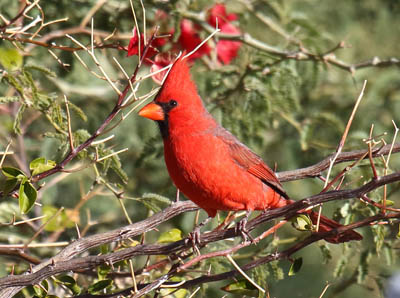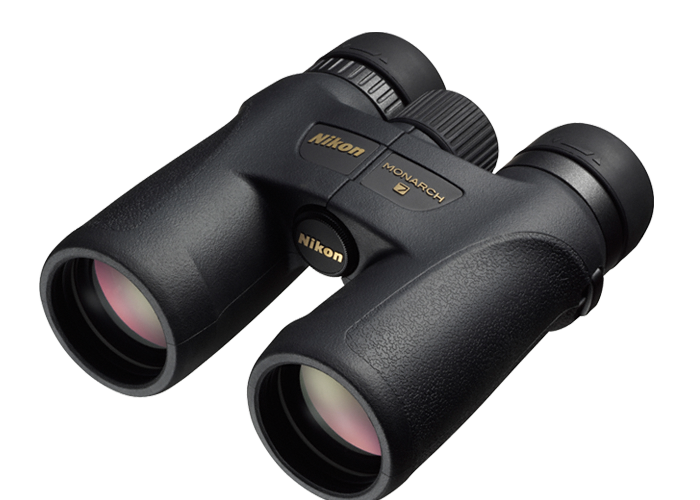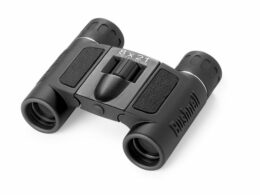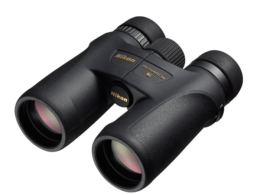Last Updated on January 24, 2024 by Greg Gillson
Do you wear eyeglasses?
Do you wonder if you can wear your glasses with binoculars?
And, if so, how do you choose the best binoculars to use with glasses?
These last two questions are the subject of this article!
Eyeglass wearers should choose binoculars with long eye relief of over 15.5 mm. A wide field of view is also helpful, especially for nature viewing.
But not all eyeglass wearers will need to wear them when using binoculars.
And if you wear contact lenses, there’s no difference between them and someone using bare eyes when viewing through binoculars!
 |
| I wish I didn’t, but I have to wear glasses when using binoculars! |
Can you wear glasses when you use binoculars?
The good news is that you can wear glasses when you use binoculars!
The even better news is that you may not need to.
Not all eye conditions requiring eyeglasses require them when using binoculars.
Do you have to wear glasses when using binoculars?
If your vision is simply nearsightedness or farsightedness, then you may be able to use binoculars without eyeglasses.
For instance, if you only wear glasses to read, then you won’t wear them when using binoculars.
Conversely, if you take your glasses off to read, then you likely don’t need to wear them, either, when using binoculars.
It is easier and preferable NOT to wear eyeglasses with binoculars. It’s a pain, I can tell you!
Glasses fog over easily in cold weather. Your eyeglasses also get pushed against your eyebrows and get greasy. And sprinkles or pollen or other debris gets smeared around on your glasses by the binoculars. Then the bridge of your nose may get sore by having the binoculars push on your glasses’ nose pads.
If you have astigmatism you should wear eyeglasses when you use binoculars.
Astigmatism is the common visual condition where the cornea of your eye is not perfectly circular . Thus, your vision will be blurry in that eye, both near and far. Astigmatism is often different in each eye.
People with astigmatism wear glasses at all times, at least, when they want to see clearly. That’s me.
So if you have astigmatism you’ll most likely want–or need–to wear your glasses.
But what if you only have astigmatism in one eye, or it isn’t very bad? Well, you might be tempted to go without glasses when using binoculars. I wouldn’t recommend it though.
Using binoculars does put some strain on your eyes, whether you wear eyeglasses or not. So I’d recommend wearing your glasses. But you might try it both ways. And don’t overdo it. Give plenty of time in between to rest your eyes. Eye strain headaches aren’t fun.
Best binoculars for use with glasses
The best binoculars for use with eyeglasses are those with long eye relief and wide field of view.
Eye relief is basically the distance from the optical lens on the binocular to the focal point. It is how far away from your eye you need to hold the binoculars to get a full view.
Obviously, your glasses prevent you from bringing the binoculars any closer to your eye. So you want your binoculars to have a longer eye relief than the distance between your eye and the outer surface of your glasses.
But the style of your glasses and the size of the lenses will be different. So will the shape of the bridge on your nose. You may need more or less eye relief than someone else who wears glasses. But both of you will definitely need longer eye relief than someone who does not wear glasses.
If your binoculars have a shorter eye relief than the distance between your eyes and glasses lens, then you will not see the entire field of view the binoculars offer. The edge all around will be restricted from your view. You will still see the object in the center of your binocular view, but the edges will vignette.
This is offset somewhat by binoculars that have an extra wide field of view. Still, you want to actually enjoy that wide field of view, not use the wider field of view to offset the narrow view given by too short of eye relief.
For bird watching, I want binoculars with a wide field of view to take in the picture window panorama, not give the impression I’m looking at the world through a straw. So getting the proper eye relief is critical.

What to look for when buying binoculars to use while wearing glasses
Eye relief
When deciding which binoculars to use or purchase for use with eyeglasses, look to the manufacturer’s specification sheet for eye relief. It is listed in millimeters (mm).
If you wear glasses then you want the eye relief spec to be at least 15.5 mm. Longer is better, out to 19 or 20 mm.
Any shorter eye relief than 15.5 mm and you will not be able to see the entire binocular view.
Field of View
Likewise, if you want to enjoy the expansive wide field of view, you want to check the spec sheet again.
Field of view is given as both a unit of degrees of a circle, and as a width. That width is commonly given as a certain number of feet at 1000 yards distance. That is, if you were looking at a fence line perpendicular to you and 1000 yards away, how much of the fence line (how wide) could you see?
For 8-power (8x) binoculars anything over 390 feet at 1000 yards is a wide angle field of view. Something around 420 feet is really good. Anything less than about 340 feet at 1000 yards is quite narrow. Binoculars advertised with the words “wide view” doesn’t mean they really are. Look at the manufacturer’s specification sheet.
For 10x binoculars, a field of view of 360 feet at 1000 yards is quite wide. The more you increase magnification, the more constricted will be your field of view with the same model of binoculars. So 8x binoculars usually have a much wider field of view than 10x or larger.
Wide field of view is especially useful when scanning for wildlife, such as bird watching or hunting. If you are looking at a fixed object, then wide field of view is not as necessary.
Adjusting binoculars and sharing binoculars with others
Using binoculars with glasses is the same as without. With the exception that you rest the eyecups of the binoculars on your glasses instead of your eye socket frontal bones.
However, if you share binoculars with others, you will need to readjust them. Just like the driver’s seat adjustments in the car, each person will have their own settings.
This is especially true if one person wears eyeglasses and the other does not.
Here’s how you adjust binoculars if sharing with others (every time):
- Push the eyecups in if you wear glasses, extend them if you do not.
- Bend the barrels in or out at the center hinge to form one seamless viewing circle when looking through them.
- Look at a mid-distant object and use the focus knob to bring your left eye into clear focus.
- Adjust the right eye diopter to bring the right eye into focus to match the left eye.
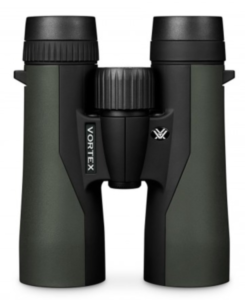
If you need more help with these adjustments, I wrote an article on How to use binoculars that goes into greater detail. It has labeled photos.
Wrapping Up
Imagine binoculars as two telescopes strapped together, each aimed at the same object. Each telescope gathers light from the object and magnifies it. Here’s a simplified explanation of how they work:
1. Objective Lens: The larger lens at the front of each telescope is called the objective lens. This lens gathers light from the distant object you’re looking at. The wider the diameter of the objective lens, the more light it collects, resulting in a brighter image.
2. Prism System: Inside each telescope, a series of prisms bend the light path by 90 degrees. This allows the binoculars to be compact and comfortable to hold while still directing the light towards your eyes. Different types of prism systems exist, affecting the size, weight, and image quality of binoculars.
3. Eyepiece Lens: After the light travels through the prisms, it reaches the smaller lens at the end of each telescope, called the eyepiece lens. This lens further magnifies the image formed by the objective lens, making it appear larger and closer to your eyes.
Putting it all together:
- Light enters the objective lens and is gathered.
- The prisms bend the light path by 90 degrees, allowing for a compact design.
- The eyepiece lens further magnifies the image, creating a larger and closer view of the object.
Additional details:
- Most binoculars can be adjusted to focus on objects at different distances by changing the distance between the objective and eyepiece lenses.
- Binoculars are often rated by their magnification and objective lens diameter, for example, “8×42” means 8 times magnification and 42mm objective lens diameter.
- Different coatings on the lenses can improve light transmission and image quality.
Simple analogy:
Think of binoculars like magnifying glasses on steroids. Instead of magnifying a flat image, they gather light from a distant object, bend the light path for convenience, and magnify it to create a closer and larger view.
Frequently Asked Questions
How do I test binoculars?
Testing binoculars before buying or using them is crucial to ensure they meet your needs and provide optimal viewing experience. Here are some key steps to follow:
Initial Checks:
- Examine the overall condition: Look for any scratches, dents, or misalignments on the body and lenses. Ensure the lenses are clean and free of dust or smudges.
- Check the interpupillary distance (IPD): This is the distance between your pupils. Adjust the interpupillary distance of the binoculars so your eyes align comfortably with the eyepieces, creating a single, circular image.
- Test the diopter adjustment: Close one eye and focus on a distant object with the other eye through one barrel. Then, close that eye and open the other. Use the diopter adjustment on one eyepiece to focus on the same object with both eyes open. Repeat for the other eye if necessary.
Image Quality:
- Brightness: Look for a well-lit image, especially in low-light conditions. Wider objective lenses (e.g., 42mm or higher) generally gather more light and provide brighter images.
- Sharpness: Focus on fine details of the object. The image should be crisp and clear, without any fuzziness or blurriness around the edges.
- Contrast: Observe the difference in light and dark areas of the image. Good binoculars should show clear variations in tone and color, not a washed-out or faded image.
- Color fidelity: Check if the colors appear natural and realistic, without any color casts or distortions.
Performance:
- Field of view: This is the area visible through the binoculars. A wider field of view allows you to scan a larger area and track moving objects more easily.
- Focus mechanism: Test how smooth and precise the focus adjustment is. It should be easy to use and allow you to quickly shift focus between objects at different distances.
- Eye relief: This is the distance between the eyepiece and your eye when the image is in focus. Proper eye relief ensures comfortable viewing and prevents eyestrain.
Why is 8×42 recommended as the best size binoculars?
8×42 binoculars are often recommended as a “best size” for several reasons, but it’s important to remember that the “best” ultimately depends on your individual needs and preferences. Here’s a breakdown of the pros and cons of 8x42s and why they are generally popular:
Pros:
- Balance between magnification and field of view: 8x magnification offers a good compromise between bringing objects closer and maintaining a wide field of view. This is useful for birding, wildlife observation, and general use where you want to see both details and the surrounding environment.
- Good light gathering ability: 42mm objective lenses collect a decent amount of light, providing relatively bright images even in low-light conditions. This is crucial for early morning or late afternoon viewing, especially in denser areas.
- Portability and comfort: Compared to higher magnification or larger objective lenses, 8×42 binoculars are generally lighter and more compact, making them easier to carry for extended periods and hold comfortably.
- Versatility: They are suitable for a wide range of activities, from birding and hiking to stargazing and sporting events.
- Price point: 8×42 binoculars often fall within a moderate price range, making them accessible to a broader audience compared to some high-end models.
Cons:
- Lower magnification for seeing distant details: If your primary goal is to observe very faraway objects or capture minute details, higher magnification binoculars might be more suitable.
- Not ideal for deep twilight or nighttime viewing: While they perform well in low light, they might not be powerful enough for extremely dark conditions compared to binoculars with even larger objective lenses.
- Bulkier than compact models: While more portable than high-powered options, they may not be the most suitable choice for minimalist packing or activities requiring constant movement.
Ultimately:
- Consider your primary use: for general birdwatching, nature walks, or casual observation, 8×42 binoculars offer a good balance of features.
- If you need more magnification for distant details, consider 10x or higher options.
- For low-light conditions or specialized activities, research models with larger objective lenses (e.g., 50mm or higher).
- Prioritize comfort and portability if you plan to hold the binoculars for extended periods or pack them on long trips.
- Compare different models within your budget and preferred specifications before making a final decision.
Related Article:
I wrote an article on what makes the best binoculars for birding, with glasses or without. That article also lists several binocular models at all price levels that are all suitable for eyeglass wearers.



